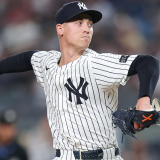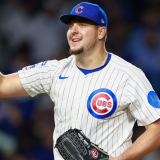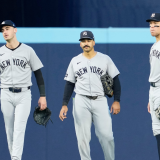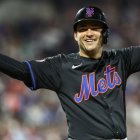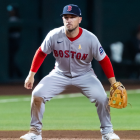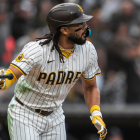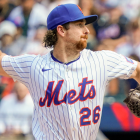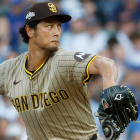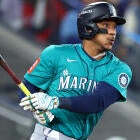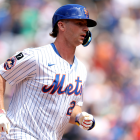
Three things to know about Mets breakout star Jose Iglesias beyond his 'OMG' remix with Pitbull
The veteran Iglesias has been an undeniable force in the Mets' wild playoff run

Last week, the New York Mets became the first team to punch their ticket to the league championship round. If you could travel back in time to June with that sentence, you would be scoffed at and justifiably labeled delusional. After a terrible May, the Mets found themselves sporting a 24-35 record on June 2. They had the third-worst record in the National League, and they seemed certain to sell when the trade season arrived.
Remarkably, the Mets recovered from their shaky stretch well and quickly enough to buy at the deadline. They won at least 60% of their games in three of the four ensuing months (including June), earning a wild-card spot in the process. It wasn't easy and it wasn't always pretty, but the Mets went from left for dead to one of the four left standing.
A universal truth in baseball is that behind every unlikely contender you'll find a slew of low-probability developments that would've felt similarly implausible just a few months prior. These Mets undeniably have their share of unexpected outcomes -- and not just in the traditional sense, as their incomprehensible co-opting of godless corporate idol Grimace proves. The most unbelievable of that bunch might be 34-year-old infielder Jose Iglesias, who didn't just prove to be a good stopgap during second baseman Jeff McNeil's absence, but who also provided the club with a fight song of sorts (including a well-timed remix featuring Pitbull and Silvestre Dangond).
McNeil is back on the roster after suffering a fractured wrist in early September. What, precisely, that means for Iglesias' playing time is to be determined. For now, we felt it was an opportune time to give Iglesias the flowers he earned since the summer. As such, here are three things to know about the unlikeliest Citi Field fan favorite.
1. Once a top prospect
Part of what makes Iglesias' contributions this season -- and mind you, he posted a 137 OPS+ and accumulated 3.1 Wins Above Replacement in just 85 games -- is that he entered the year as a known quantity. He's been on the national radar since he signed with the Boston Red Sox as an international free agent in 2009. Back then, scouts were enamored with Iglesias' silky-smooth glovework and anticipated he would win a few Gold Glove Awards before his playing career ended. (Surprisingly, he hasn't won any.)
Jose Iglesias with a monumental effort to get the out at second base! pic.twitter.com/08ZgrOuhlc
— MLB (@MLB) August 25, 2024
For as fond as evaluators were of Iglesias' defense, they didn't share the same cheerfulness about his bat. "Sure he's a great defender, but he just can't hit a lick," a scouting official told Baseball Prospectus' Kevin Goldstein (now with the Minnesota Twins) in 2011. "For me, he's just Rey Ordóñez, Part II."
Iglesias, to his credit, was able to beat those charges. Even entering this season, his career 88 OPS+ was leaps and bounds better than Ordóñez's 59 mark. Still, the idea of Iglesias batting fifth for a plausible World Series team in 2024, the way he did during the NLDS, was … well, outlandish -- in no small part because of last year.
2. Appeared to be on his last legs
Generally, you can discern a lot about a player's perceived talent level by how teams treat them and what opportunities they're afforded. It was notable, then, that last season marked the first time Iglesias had not received a single MLB plate appearance since 2014, when he missed the entirety of the campaign on account of injury.
Iglesias wasn't hurt last season -- not physically, anyway. He had two minor-league stints with the San Diego Padres organization and one with the Marlins. But he didn't do enough during his time in Triple-A to convince either club (or any other) that he was worth fielding on the active roster. Given Iglesias' advanced age, it was fair to think that he was moving into the organizational depth phase of his career -- a fancy way of writing that he was going to be earmarked as someone who would get a look only in emergency situations.
OMG REMIX DAY@JoseIglesias_SS x @pitbull 🔥
— x - New York Mets (@Mets) October 11, 2024
🎶👉 https://t.co/2htpdG0GX1 pic.twitter.com/wcGqFCnVK8
Iglesias even told the New York Post in late June that he "a hundred percent" thought his baseball career might be over because of how last year played out for him. "Sometimes things happen for a reason," he said. "You can't explain it."
Even the Mets didn't seem to have great expectations for Iglesias. Here's what top baseball operations executive David Stearns said of Iglesias when the Mets signed him to a minor-league pact last December: "He's an established veteran shortstop who has played at the big-league level. He knows how to play the position and gives us a level of depth." Not exactly the highest of praise or sweetest of projections.
So, just how did Iglesias find himself playing a pivotal role for these Mets?
3. Notable shift in approach
The fascinating part about Iglesias' season is that a lot of his underlying indicators remain true to his past. His offensive foundation is and has always been built on contact; he's not someone who is going to slug or steadily impact the ball, nor is he the kind of player who can command the strike zone and amass a ton of walks.
The one big difference we flagged between this version of Iglesias and those in years past is where he's hitting the ball. Iglesias has seemingly embraced using the opposite field, hitting nearly 32% of his batted balls to right. For reference, he had topped 25% in that category once in the last five years, with that coming during the 2020 campaign.
| Season | Oppo% |
|---|---|
2019 | 24% |
2020 | 25.4% |
2021 | 23.5% |
2022 | 22.5% |
2024 | 31.9% |
It's an interesting shift, one that in our estimation aligns better with Iglesias' game. As Drew Haugen wrote early this year for Down on the Farm: "[Hitters] on the lower end of the raw power spectrum follow a different pattern in spray angle production than heavier hitters; production to the opposite field is much better, relative to pull-side, for players with less raw than plus raw power hitters."
Iglesias, who has routinely ranked near the bottom of the league in average exit velocity, certainly qualifies in that respect, suggesting that his opposite-field approach plays better to his strengths. Does that mean that teams will view Iglesias as a plus hitter this winter, when he reaches the free-agent market of his 35th birthday? No, of course not. Yet it may help explain some of his overperformance this season, and it goes to show that in baseball -- as with life -- there's always time to reinvent the self.


